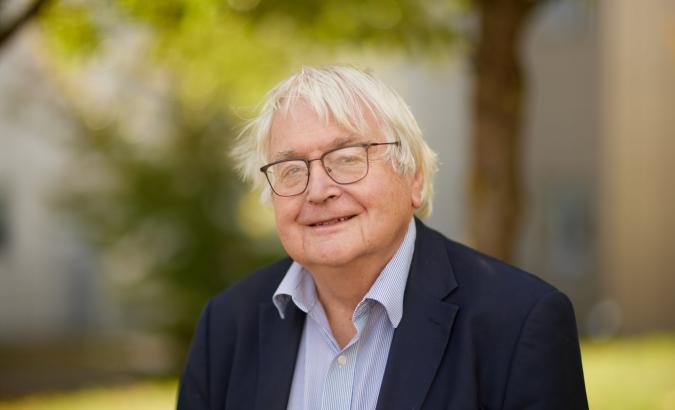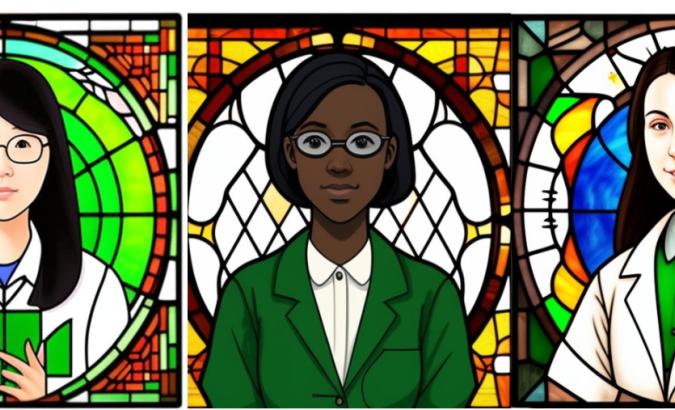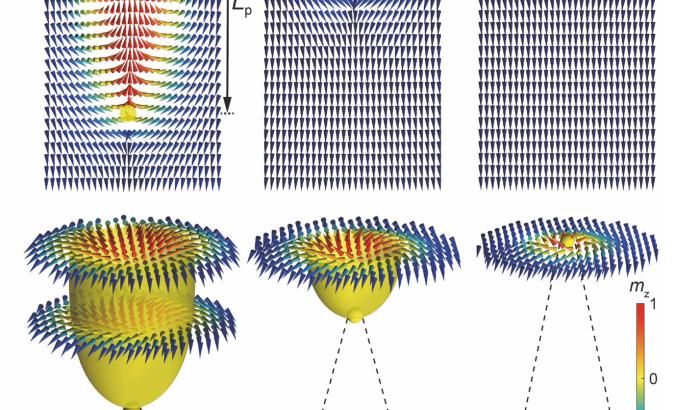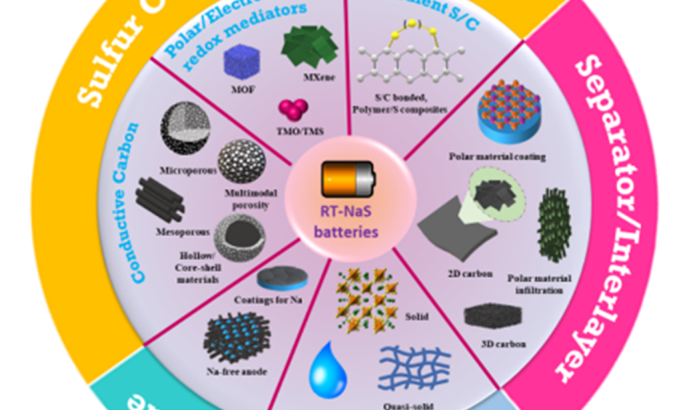Sir Richard Catlow is one of the world’s leading chemists, honoured this summer with a knighthood in the Queen’s Birthday Honours in recognition of his many services to leadership in science and research. He holds concurrent positions as Professor of Computational and Materials Chemistry at UCL and Professor of Catalytic and Computational Chemistry at Cardiff University. Educated at Oxford, he has taught at Keele and was Director of the Davy-Faraday Research Laboratory and Wolfson Professor of Natural Philosophy at the Royal Institution. Since 2016, he has served as Foreign Secretary of the Royal Society.
For over thirty years, Sir Richard has led the way in computational and experimental studies of complex inorganic materials receiving many prestigious accolades along the way. His research has led to over 1000 publications. He is also the Prime Investigator of the ‘Optimising, Predicting and Designing New Catalysts’ Theme of the UK Catalysis Hub based at the Research Complex at Harwell. As one of the founding members of UK Catalysis Hub, he has been instrumental to the wide success of the Hub. He has helped lead research programs that make use of the proximity of the Research Complex at Harwell to the large facilities such as Diamond Light Source, Central Laser Facility and ISIS Neutron and Muon Source.
Sir Richard talks to Alison Oliver, Communications and Engagement Officer at the Research Complex at Harwell about his education and career, the foundations behind his pioneering work in computational techniques and simulation methods, working with the late Sir John Meurig Thomas, his role with the Royal Society and his continued work at the Research Complex.
Q: You studied chemistry at Oxford, obtaining a Doctor of Philosophy in 1974. What was it that introduced you to chemistry as a discipline and what led to you studying the subject at university?
I would not have followed a scientific career if I had not been introduced to science so well at school, where I was fortunate enough to have excellent teachers. I enjoyed all the sciences, but especially chemistry and physics. In fact, if you look at a lot of my research, it has been at the interface between chemistry and physics, particularly early on in my career.
I think what fascinated me about science was just the simple fact that it allows the world to make sense. At the age of 14, it really struck me that science allowed me to begin to understand the world. Much later in life, I came across a quote by Einstein, ‘The most remarkable thing about the universe is the fact that we can understand it.’
Chemistry probably suited my kind of mindset better because chemistry tries to look at the world in all its complexity.
Q: What were the first few steps in your career after your first degree?
I studied for my DPhil at Oxford and my research was carried out entirely at the Atomic Energy Research Establishment. That was a lucky break for me as it was a fantastic place. I got in during the very early days of computational modelling in solid state science. I remained in Oxford for a further three years as a Junior Research Fellow before moving to UCL to become a lecturer from 1976-1985. Then I moved to the University of Keele where I was a Professor which was a great opportunity as my work was divided between Keele and Daresbury Laboratory, with the pioneering synchrotron radiation source. My role at Daresbury was to help develop the power of diffraction facilities and that really cemented my long-standing interaction with synchrotron radiation techniques.
Q: In 1989, you became Director of the Davy-Faraday Research Laboratory and Wolfson Professor of Natural Philosophyat the Royal Institution. What are your memories when you look back on these times?
The whole RI experience was wonderful. It was a unique organization and an inspirational place to work. It combined a large and high-quality research programme, with public engagement in science, especially with young people. We had a great research program and I worked with Sir John Meurig Thomas and Peter Day, brilliant scientists, both of whom we’ve sadly lost very recently. We had a strong unit for material chemistry and engaged extensively with research facilities. I was there for quite a long time, am grateful to have had the opportunity to work at the RI and feel so proud of the work we accomplished. I then moved back to UCL to become Head of Chemistry and later Dean of Mathematical and Physical Sciences both of which were extremely rewarding roles and then since 2014, I’ve been a Research Professor, splitting my time between UCL and Cardiff.
Q: Congratulations on your recent knighthood for services to science and research. You are best known for your innovative work in a wide range of applications involving computational techniques in solid state chemistry, catalysis, and mineralogy. What was the research that led to your understanding of how defects — missing or extra atoms — in the structure of solids can result in non-stoichiometric compounds? What set you and your team on the right path?
Being fortunate enough to do my doctorate in the Theory Division of the Atomic Energy Research Establishment, I was able to get involved in computer modelling techniques in science. The particular emphasis of the work there was on the modelling of defects and solids which are absolutely vital, as they are always present in solids and control many of their key properties.
What we were able to do at Harwell was to learn about the details of the defect structures which are obtained, and, in particularly, how the formation of these defects – missing or extra atoms – helps to accommodate non-stoichiometry – changes in the chemical composition of a compound – which is an important and common phenomenon, especially in metal oxides. We were able to elucidate this, by using the recently developed computer modelling techniques, which could show how the interactions and clustering of the defects stabilised the non-stoichiometry
I worked very well with two people – Sir Brian Fender, who did experimental work using neutron scattering and one of Brian’s then PhD students, Tony Cheetham, who went onto become a highly successful scientist and an officer of the Royal Society.
“despite Brexit, the UK will remain a very active, European scientific nation”
Q: In structural chemistry and mineralogy, you also pioneered the use of simulation methods to predict the structures of complex solids and silicates. What was the research that led to this discovery?
As I said, I studied with an excellent and innovative bunch of physicists at Harwell, but I was a chemist at heart. I considered whether we could start using some of the techniques which we developed, that, overall, were focused on relatively simple compounds, and instead use them to look at more complex solids. So, along with the help of an exceptionally talented PhD student, Steve Parker, who is now a senior professor at the University of Bath, we essentially had a go at adapting these techniques to see if we could model silicates and we could! It was one of the times in my career that I still look back on with great satisfaction. I was also greatly influenced by Sir John Meurig Thomas. He realized the value of computer modelling and actively encouraged me to apply the work to silicate systems.
Q: You currently hold a joint professorship as Professor of Computational and Materials Chemistry at UCL and Professor of Catalytic and Computational Chemistry at Cardiff University. Over the years, how has the teaching of chemistry evolved and adapted to meet the changing needs of students?
I have always really enjoyed teaching and I still do some, but less since becoming more involved in university senior management. I really like the interaction with students and teaching has changed a lot. It is worth noting that chemistry as a discipline has also changed a great deal. Chemistry still retains its core, but some of the most active areas like materials chemistry and chemical biology were embryonic when I first started. We now cover a range of topics that were hardly covered 30-40 years ago. People like Sir John Meurig Thomas, who was working in solid state chemistry and Charles Vernon at UCL in chemical biology were doing great work but to a large extent in isolation; but the areas they worked in are mainstream now.
I think the way teaching is done now is better, in that it is considerably more professional and responsive to students’ needs. Early in my career, you would give a lecture, give some tutorials but that would be it! Now it is much more interactive, and you receive valuable student feedback. Although we work more in smaller groups these days, I think there is still a place for a good traditional lecture, summarizing a topic.
Q: Does your teaching and research motivate and influence each other? Do you continue to get research ideas from your work and incorporate your ideas into your teaching?
I very much believe in research-led teaching. Teaching is stimulating for your understanding of the discipline. I learnt a lot through teaching and got so many ideas, sometimes just before giving a lecture when having a final check of my notes. At UCL, I contribute to a final year module on intense radiation sources, so I talk about some of the work at the Catalysis Hub on applying neutron and synchrotron techniques in catalysis.
There is something wonderful about excellent science being initiated by a casual conversation in a corridor or over a cup of coffee, which is helped when you have the Central Laser Facility within the same building, Diamond is next door and ISIS is a five-minute walk away.
Q: You are both Foreign Secretary and Vice President at the Royal Society where you were elected as a Fellow in 2004. Please could you tell us more about these roles and what they entail?
I am a member of the Council of the Royal Society and one of the senior trustees. We have a large and wide- ranging program. My particular focus is the international work of the society. We help organise and contribute towards events, international meetings and seminars. Every four years, we run a Commonwealth Science Conference, which brings scientists, particularly early career scientists from all over the Commonwealth together. This will run as a virtual meeting in February and the overall theme is using science to develop resilience in the future, particularly in what will be a post-pandemic world.
The society is a highly active member of several international groupings such as the Inter-Academy Partnership and the International Science Council. We also contribute to regional groupings. There is a grouping named the European Academy Science Advisory Council, which again produces statements on European science policy with particularly strong emphasis on interaction with the European Union. We represent UK Science at various occasions and over the last four years have been meeting academies, funding agencies and scientific bodies in Europe, because we really wanted to emphasize that despite Brexit, the UK will remain a very active, European scientific nation.
There is something wonderful about excellent science being initiated by a casual conversation in a corridor or over a cup of coffee, which is helped when you have the Central Laser Facility within the same building, Diamond is next door and ISIS is a five-minute walk away.
Q: You are also the principal investigator of the ‘Optimising, Predicting and Designing New Catalysts’ Theme of the UK Catalysis Hub based here at the Research Complex at Harwell, helping to lead research programs that develop new techniques in the understanding of catalytic processes. Please could you tell us about some of the current research going on?
The research is about exploring the fundamentals of catalytic science, in particular, obtaining and understanding the molecular level of catalytic processes. What we have learned probably over the last 40 years is that by obtaining that fundamental molecular level understanding, we can indeed improve catalytic systems. We make extensive use of computation, which has long been one of our specialities, which allows us to understand mechanisms of catalytic reactions and increasingly predict catalytic processes.
One of the great successes of the team has been the way it has developed and applied the huge potential of the facilities on the whole campus for catalytic science. I think we have done a lot of particularly good work in synchrotron radiation, and in particular the development of what they call in-situ methods which allow you to do experiments on catalysts while they’re actually doing their job. I would highlight one area by my colleague Andy Beale on the use of advanced imaging techniques. I have not really been involved, but the work has been absolutely terrific. It really allows you to look at what is going on in a catalyst particle in detail. The other really big success is the way in which we have harnessed neutron scattering techniques. A lot of beautiful work had been done by Stewart Parker in the ISIS team and David Lennon at the University of Glasgow, but it was more of a niche area. I think the Hub has helped make neutron spectroscopy much more of a mainstream technique. I give credit to a PhD student who started at the Hub, Alex O’Malley, who is now a research fellow at Bath. He really ran with the use of the quasi-elastic neutron scattering technique to understand molecular mobility in catalysts.
Q: How important is Research Complex’s multidisciplinary and co-location with large scale facilities?
It has played an absolutely vital role. There has been very impressive work led by Andy Beale with the Central Laser Facility but that interaction with the lasers would never have happened if the hub team had not been based within the Research Complex. There is something wonderful about excellent science being initiated by a casual conversation in a corridor or over a cup of coffee, which is helped when you have the Central Laser Facility within the same building, Diamond is next door and ISIS is a five-minute walk away.
Carbon dioxide activation and the conversion of carbon dioxide into useful chemicals and fuels is one of the really grand challenges in chemistry in general and catalytic science. I think the expertise that we have got in the hub in the Harwell team and elsewhere on campus is really beginning to make a big contribution to that field I also think the interdisciplinary structure is beneficial. We should promote that more within the Research Complex. For instance, some of the work now focuses on biocatalysis and we could really benefit from stronger interaction with the life scientists in the Research Complex.
Overall, the location near the facilities and the interdisciplinary ethos of the Research Complex is really important to us.
Q: How would you encourage young people to get into chemistry? What words of advice would you give someone hoping to make it into a career?
I do not think there’s been a better time to be a scientist. With science, you are doing something that is not only absolutely fascinating and rewarding, but also absolutely vital for the future of the world. The big challenges we face in health, energy and climate change will all need innovation in physical and life sciences, but also input from social sciences and humanities. Let us take net zero for example. The misconception is that we have what we require, and we just must roll it out and deploy it. Not true, we have some of what we require but we need a lot of developments in fundamental science and technology, if we are going to achieve net zero.
To summarise, it is a great, really rewarding and exciting career and it’s absolutely vital for the future viability of our way of life on the planet.
Q: You have authored over 1000 publications. Is there a particular article that you are most proud of?
The development of modelling silicates was very much led by Steve Parker and the influence of Sir John Meurig Thomas. In 1982, we published a paper in Nature that essentially showed that these modelling works had helped to explain some of the experimental microscopy data that Thomas’s group had obtained. Then sometime later, I got more involved with synchrotron radiation techniques, in particular X-ray spectroscopy, working with Alan Chadwick, a long-standing colleague and friend, and the late Neville Greaves, who did much of the work that developed X-ray spectroscopy, particularly at Daresbury. In 1984, we published an article, again in Nature where it featured on the front cover, which showed how X-ray spectroscopy could help you develop models for the structures of complex defect aggregates in fluorite structure crystals. I think that was a key development because it showed that these X-ray spectroscopy methods could get to grips with complex important problems in materials chemistry.
I’ll now step forward 35 years and pick a paper written with Graham Hutchings and many others. Graham is a leading figure in the Hub and a world leading catalytic scientist who pioneered the use of gold in catalytic science. The paper was about a catalytic process that Graham developed many years ago using gold-based catalysts to convert acetylene, reacting with hydrogen chloride, into vinyl fluoride, which is then used to make polyvinyl chloride, an important fabric and material. That process is now industrialized in China and has made an important environmental contribution, as previously mercury was used. We wanted to understand the molecular level processes and by using X-ray spectroscopy and the beamline at Diamond, we were able to elucidate that the active site for this catalyst was single gold cations. Very recently, I was involved with work led by Andy Beale that used modulated excitation spectroscopy to understand and help develop models for some of the intermediates in auto exhaust catalysis, which was published earlier this year.
Q: What has been the most exciting development that you have worked on during your career?
I would probably highlight the computational techniques because, over the course of my career, I have seen those develop from being a niche area of materials physics into a major technique that is now very widely applied. If you look at the contemporary literature in journals on catalytic science, well over half of the papers published will have a contribution from computational modelling, which has been fantastic to see. I’ve been involved in synchrotron and neutron techniques since early in my career and again, it has been great seeing how the impact and applications of those techniques in our field and many others have developed.
Q: What do you think the most important recent developments in the field have been? What do you think will be the most exciting and productive areas of research in chemistry during the next few years?
There are hugely exciting developments and challenges within materials chemistry – energy technologies and catalysis. Computer modelling techniques have helped us understand so much which is extremely valuable but now they are genuinely becoming more predictive, which I think is very exciting.
As a global community, we need to have resilient technologies and policies to help us cope in the future. Science and technology will make a huge contribution.
Q: As we endure the pandemic, what do you see as the greatest challenges facing the scientific community in the coming years?
I think the greatest challenge is resilience. There will be further challenges, whether that be another pandemic, or the challenges related to climate change, and we need to develop resilient systems to cope with these challenges. I am not an expert on pandemics, and I am not criticising anyone, but a lot of nations were not prepared and didn’t have the resilience. As a global community, we need to have resilient technologies and policies to help us cope in the future. Science and technology will make a huge contribution.
Q: Who have been the people who have been influential in your career? Also, given that you are one of the most well-respected chemists of your generation and many chemists look up to you, whose work do you admire?
Like I said, I was so fortunate to have great science teachers in school and if such teaching doesn’t continue, we won’t have a good science base to fight future pandemics and such challenges. My tutors at Oxford, Peter Day and John White were excellent. At Harwell, Alan Lidiard, who was my supervisor and Marshall Stoneham, both inspirational figures in my early career, as was Sir John Meurig Thomas, to whom I owe such a debt. Graham Hutchings is a great colleague and friend and I respect that way he has stuck with key problems for many years. There is a tendency in science to follow the latest fashionable areas, which does need to happen but on the other hand, we need to keep working on difficult problems. He stuck for example with methane conversion – one of the grand challenges in catalytic science – for over 30 years and has made such key contributions.
Q: If you had not got involved in the field of chemistry, what do you think you would have done? (Is there another field that you could have seen yourself making an impact on?)
It’s a really interesting question because with the direction of one’s career, there is often a lot of luck involved. My career would not have developed as it did if I had not done my PhD at Harwell. I knew I wanted to do research, but I wasn’t quite sure what I wanted to do. A tutor at Oxford – a distinguished scientist named Roger Elliott – recommended that I go to Harwell and that was a good bit of luck!
I am confident that I would have remained in science and I did seriously think about continuing to work at Harwell because it was such an exciting scientific environment. If I hadn’t obtained a lectureship in 1976, then my career would have been more involved in physics. I could have become more of a solid-state physicist, rather than materials chemist, but materials chemistry and catalysis suited my mindset.
Image appears courtesy of The Royal Society





